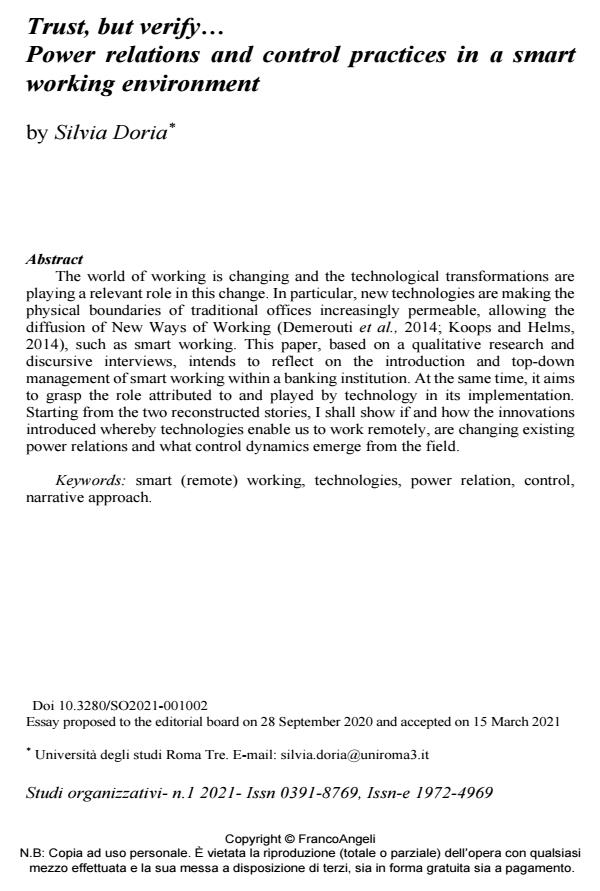Trust, but verify.. Power relations and control practices in a smart working environment
Titolo Rivista STUDI ORGANIZZATIVI
Autori/Curatori Silvia Doria
Anno di pubblicazione 2021 Fascicolo 2021/1
Lingua Inglese Numero pagine 24 P. 24-50 Dimensione file 268 KB
DOI 10.3280/SO2021-001002
Il DOI è il codice a barre della proprietà intellettuale: per saperne di più
clicca qui
Qui sotto puoi vedere in anteprima la prima pagina di questo articolo.
Se questo articolo ti interessa, lo puoi acquistare (e scaricare in formato pdf) seguendo le facili indicazioni per acquistare il download credit. Acquista Download Credits per scaricare questo Articolo in formato PDF

FrancoAngeli è membro della Publishers International Linking Association, Inc (PILA)associazione indipendente e non profit per facilitare (attraverso i servizi tecnologici implementati da CrossRef.org) l’accesso degli studiosi ai contenuti digitali nelle pubblicazioni professionali e scientifiche
The world of working is changing and the technological transformations are playing a relevant role in this change. In particular, new technologies are making the physical boundaries of traditional offices increasingly permeable, allowing the diffusion of New Ways of Working (Demerouti et al., 2014; Koops and Helms, 2014), such as smart working. This paper, based on a qualitative research and discursive interviews, intends to reflect on the introduction and top-down management of smart working within a banking institution. At the same time, it aims to grasp the role attributed to and played by technology in its implementation. Starting from the two reconstructed stories, I shall show if and how the innovations introduced whereby technologies enable us to work remotely, are changing existing power relations and what control dynamics emerge from the field.
Il mondo del lavoro sta cambiando e la trasformazione digitale sta giocando un ruolo rilevante in questo cambiamento In particolare, le nuove tecnologie stanno rendendo sempre più permeabili i confini dei tradizionali uffici, permettendo la diffusione dei New Ways of Working (Demerouti et al., 2014; de Kok, Koops and Helms, 2014), di cui lo smart working (o lavoro agile) è un esempio. Il paper, basato su una ricerca qualitativa con interviste discorsive, intende riflettere sull’introduzione dello smart working all’interno di un istituto bancario e sulla gestione top-down del cambiamento. Al contempo, mira a cogliere il ruolo attribuito e giocato dalle tecnologie nella sua implementazione. Dalle due storie ricostruite, sarà possibile riflettere su se e come le innovazioni introdotte dal nuovo progetto, in cui le tecnologie abilitano a lavorare da remoto, stiano cambiando le relazioni di potere esistenti e quali dinamiche di controllo emergano dal campo.
Parole chiave:Smart working; tecnologie; potere e controllo; approccio narrativo.
Silvia Doria, Trust, but verify.. Power relations and control practices in a smart working environment in "STUDI ORGANIZZATIVI " 1/2021, pp 24-50, DOI: 10.3280/SO2021-001002